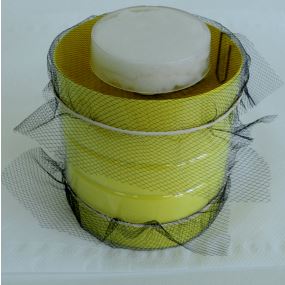This is the most succinct small scale production technique I have found. It uses easily accessible feeding materials, as well as inexpensive materials to create enclosures. It could likely use some adaptation to efficiently store the containers, however for my purpose this method should do well.

Adult Lacewings are held in containers made from plastic bottles, cut to 80mm x 100mm. The inside of the cylinder is lined with yellow cardboard, and then the tops are lined with tulle mesh (1.4mm openings)
A half petri dish filled with cotton wool sits on top of the mesh, and it should be saturated with water however not dripping.
Each one of these containers can hold up to four pairs of lacewings.
Environmental Conditions:
Temperature: 20 ± 2°C
Humidity: 65 ± 5%
Photoperiod: 16:8h
Food: Adult lacewings are fed honeybee pollen loads. About 300mg is place at the bottom of each cage.
Larvae are fed mealworms (Tenebrio Molitor). These can be provided already dead to simplify this process. I will either rear these mealworms (which is easy, I have done it on accident before in my terrariums), or buy them. They are widely available as pet food. A drop of sucrose solution should be provided for newly hatched larvae as well.
Each larvae is fed three mealworms per week, or sooner if they manage to eat them quicker. Whenever they eliminate their food they should be given more.
Here is a table to determine what size mealworm to feed each instar. I should be able to do this by sight after some experience.
| Instar | Size (mm) | Weight (mg) |
| 1 | 4-5 | .5 -1 |
| 2 | 6-8 | 2-4 |
| 3 | 9-12 | 6-12 |
Storage: Lacewing eggs kept at 8°C are viable for a few weeks, so if I am shipping eggs, it will be important to send them in insulated containers with cold packs. Larvae will need to be somewhat isolated to prevent cannibalism; providing them food within their storage or feeding them before they are shipped can help prevent this to some extent. Overnight shipping with cool packs should be enough to do the job here, and if I am selling them to a distributor or client locally it should be easy enough to store and transport them.
Eggs will be held in a bran medium when they are stored, and they can be distributed this way. I am going to experiment with other application and storage techniques though. Some companies ship them on cards, which you then simply place out.
Conclusion:
This method is simple, but straightforward. Many of the materials required are recycled (water bottles), and the enclosures are entirely inexpensive to create.
There is no listed enclosure developed for larvae, and they must be house separately. This will be something I need to develop on my own, however a plastic box with many cells would likely be a good enough solution.
Also, the individual enclosures will need to be optimized. A larger container that fits many of them may solve this, just so many containers could be moved at once. This should be easy enough to set up.
While it is unlikely that I can use this method to sustain a population of lacewings that is commercially viable, if it is optimized, with larger and more compartmentalized enclosures, it may do the job. Either way, it should be an easy enough way to get my feet in the water.
I’m going to look into gathering materials for this, come up with how much it costs to create them, and make sure I have a few for the beginning of next quarter.